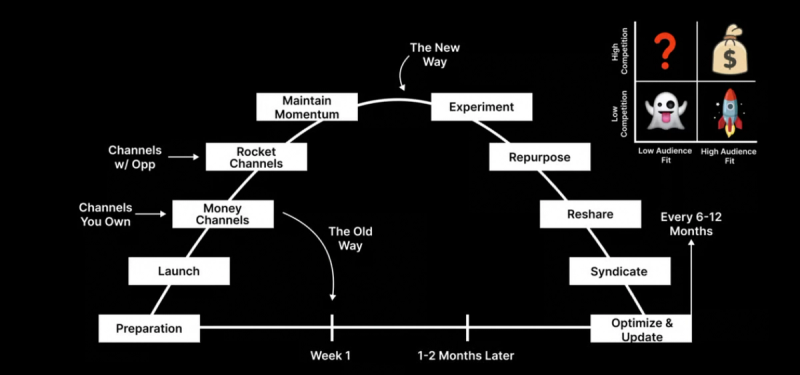How To Extend The Life-Cycle Of Your Content With Strategic Distribution
I know the feeling of creating a piece of content that underperforms.
You spent days, if not weeks, on it, only to press publish - then crickets.
The majority of the time, it's not the piece of content, it's your distribution strategy after publishing.
And in this case study, we're breaking down how my good friend Ross Simmonds maximizes the reach of every piece of content he creates.
This is from his Whiteboard Friday with Moz.
We're going to dissect the 8-steps to increase the reach of your content:

1. Create With Intent
Understand the why behind a piece of content to create with intent.
They’re looking for value — hand deliver it to them.
That starts with research.
Here’s a simple series of steps to help you do this:
- Go to answerthepublic.com
- Enter a keyword(s) related to the content you’re creating
- Take a “Highly Searched” term or question for the base of your content
- Then go to buzzsumo.com and enter that same keyword or phrase
- Find the content with the most social shares and that’s also “evergreen”
With this data, now ask yourself two questions:
- What is a goal your audience is trying to achieve?
- How can you make this easier?
So, now take your research and use these two questions to create content that earns attention and creates intent.
2. Treat It Like A Shoe Drop
No one knows your content is getting published other than you…
Unless you treat your publishing date like a shoe drop.
Here’s how:
- Talk about what’s coming
- What to expect
- When it’s coming
You’re job as a marketer is to create excitement and convert excitement into engagement and traffic.
3. Launch & Distribute
Launch and distribute, aka publish and promote.
And there are two types of channels you should spend the majority of your time distributing your content:
Money Channels: Channels with high competition and high audience fit.
Rocket Channels: Channels with low competition and high audience fit.
Let’s take Marketing Examined for example:
- Twitter would be the Money Channel with high competition and high audience fit. Competition is there. The audience is there. But I can still extract a ton of value from publishing my content there.
- Youtube Shorts can be my Rocket Channel with low competition and high audience fit. A lot of marketers and founders but not too many newsletter creators or businesses creating Youtube Shorts content.
Find these opportunities and exploit them.
4. Experiment
Experimenting is like going to the buffet. You snag a plate and stack it up with everything and anything, knowing you're trying different foods.
For your content, it’s no different - let’s say you wrote an article, you’d now experiment with:
- Creating an infographic
- Creating quick tips
- Writing a thread
- Creating short-form videos
- Creating long-form videos
- Running ads
- Sponsoring newsletters, publications, posts, podcasts, or videos
Test, refine, optimize and then scale.
When I start running experiments, I set specific KPIs that determine what equates to success or not.
When an experiment hits the benchmark KPI - then I start refining and optimizing it to see if the success is repeatable.
If yes, I scale.
5. Repurpose
Your experiments will determine how you repurpose your content.
Because what’s published in one format should never ONLY live in one format.
It should be remixed to live through other formats too.
For example: Newsletters → Article → Twitter Thread → Podcast → Short Form Clips
6. Reshare
What you posted once should get posted again.
Because chances are the fraction of people who saw your original piece of content will be different than the group who sees it in the future.
Plus, if you’ve grown your audience during that time, then resharing your content puts a valuable piece of content in front of a new group of people.
7. Syndicate
Now, how do you take everything and make it work cohesively?
By syndicating your content.
So, take your article - if you made a Youtube video, then embed it into your article, and the same goes for your infographic and tweets that complement your original article.
Now, this one article extends into every other piece of content you create.
8. Optimize & Update
Lastly, every 6 to 12 months, take your content and refresh it.
Find what’s changed within that timeframe and use it to optimize your content.
Putting It All Together
- Understand the why behind a piece of content to create with intent
- Don't just blast a piece of content, treat it like a shoe drop
- Launch then distribute on money channels and rocket channels
- Experiment different content types before repurposing at scale
- Reshare your content after a specific time period
- Syndicate your content to create an awareness flywheel
- Optimize and update your content every 6 to 12 months


